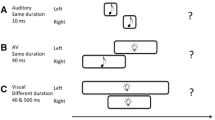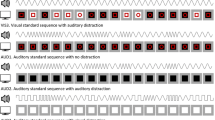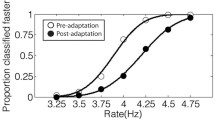Abstract
The present study investigated modality-specific differences in processing of temporal information in the subsecond range. For this purpose, participants performed auditory and visual versions of a rhythm perception and three different duration discrimination tasks to allow for a direct, systematic comparison across both sensory modalities. Our findings clearly indicate higher temporal sensitivity in the auditory than in the visual domain irrespective of type of timing task. To further evaluate whether there is evidence for a common modality-independent timing mechanism or for multiple modality-specific mechanisms, we used structural equation modeling to test three different theoretical models. Neither a single modality-independent timing mechanism, nor two independent modality-specific timing mechanisms fitted the empirical data. Rather, the data are well described by a hierarchical model with modality-specific visual and auditory temporal processing at a first level and a modality-independent processing system at a second level of the hierarchy.


Similar content being viewed by others
References
Allan, L. G., & Kristofferson, A. B. (1974). Psychophysical theories of duration discrimination. Perception & Psychophysics, 16, 26–34.
Allan, L. G., Kristofferson, A. B., & Wiens, E. W. (1971). Duration discrimination of brief light flashes. Perception & Psychophysics, 9, 327–334.
Brebner, J. M. T., & Welford, A. T. (1980). Introduction: An historical background sketch. In A. T. Welford (Ed.), Reaction times. London: Academic Press.
Browne, M. W., & Cudeck, R. (1993). Alternative ways of assessing model fit. In K. A. Bollen & J. S. Long (Eds.), Testing structural equation models (pp. 136–162). Newbury Park, CA: Sage.
Carroll, J. B. (1993). Human cognitive abilities. A survey of factoranalytical studies. New York: Cambridge University Press.
Chen, Y. G., Huang, X. T., Luo, Y. M., Peng, C. H., & Liu, C. X. (2010). Differences in the neural basis of automatic auditory and visual time perception: ERP evidence from an across-modal delayed response oddball task. Brain Research, 1325, 100–111.
Church, R. M. (1984). Properties of the internal clock. In J. Gibbon & L. Allan (Eds.), Timing and time perception. New York: Academy of Sciences.
Collier, G. L., & Logan, G. (2000). Modality differences in short-term memory for rhythms. Memory & Cognition, 28, 529–538.
Craig, J. C. (1973). Constant error in perception of brief temporal intervals. Perception & Psychophysics, 13, 99–104.
Creelman, C. D. (1962). Human discrimination of auditory duration. Journal of the Acoustical Society of America, 34, 582–593.
Demany, L., McKenzie, B., & Vurpillot, E. (1977). Rhythm perception in early infancy. Nature, 266, 718–719.
Exner, S. (1875). Experimentelle Untersuchung der einfachsten psychischen Processe. Archiv für die gesammte Physiologie des Menschen und der Thiere, 11, 403–432.
Fraisse, P. (1985). Psychologie der Zeit. München: Ernst Reinhardt.
Garlick, D. (2002). Understanding the nature of the general factor of intelligence: The role of individual differences in neural plasticity as an explanatory mechanism. Psychological Review, 109, 116–136.
Gibbon, J., & Church, R. M. (1984). Sources of variance in an information processing theory of timing. In H. L. Roitblat, T. G. Bever, & H. S. Terrace (Eds.), Animal cognition (pp. 465–488). Hillsdale, NJ: Erlbaum.
Goldstone, S. (1968). Reaction time to onset and termination of lights and sounds. Perceptual and Motor Skills, 27, 1023–1029.
Grondin, S. (1993). Duration discrimination of empty and filled intervals marked by auditory and visual signals. Perception & Psychophysics, 54, 383–394.
Grondin, S. (2001). From physical time to the first and second moments of psychological time. Psychological Bulletin, 127, 22–44.
Grondin, S., Meilleur-Wells, G., Ouellette, C., & Macar, F. (1998). Sensory effects on judgments of short time-intervals. Psychological Research, 61, 261–268.
Grondin, S., & Rammsayer, T. (2003). Variable foreperiods and temporal discrimination. Quarterly Journal of Experimental Psychology, Section A: Human Experimental Psychology, 56, 731–765.
Haier, R. J. (1993). Cerebral glucose metabolism and intelligence. In P. A. Vernon (Ed.), Biological approaches to the study of human intelligence (pp. 317–332). Norwood, NJ: Ablex.
Hirsh, I. J., & Fraisse, P. (1964). Simultanéité et succession de stimuli hétérogènes. Année Psychologique, 64, 1–19.
Jensen, A. R. (1982). Reaction time and psychometric g. In H. J. Eysenck (Ed.), A model for intelligence (pp. 93–132). New York: Springer.
Jensen, A. R. (2006). Clocking the mind. Mental chronometry and individual differences. Amsterdam: Elsevier.
Jokiniemi, M., Raisamo, R., Lylykangas, J., & Surakka, V. (2008). Crossmodal rhythm perception. Haptic and Audio Interaction Design, 5270, 111–119.
Kaernbach, C. (1991). Simple adaptive testing with the weighted up-down method. Perception & Psychophysics, 49, 227–229.
Kanabus, M., Szelag, E., Rojek, E., & Pöppel, E. (2002). Temporal order judgement for auditory and visual stimuli. Acta Neurobiologiae Experimentalis, 62, 263–270.
Klapproth, F. (2002). The effect of study-test modalities on the remembrance of subjective duration from long-term memory. Behavioural Processes, 59, 37–46.
Kline, R. B. (1998). Principles and practice of structural equation modeling. New York: Guilford Press.
Lapid, E., Ulrich, R., & Rammsayer, T. (2008). On estimating the difference limen in duration discrimination tasks: A comparison of the 2AFC and the reminder task. Perception & Psychophysics, 70, 291–305.
Lapid, E., Ulrich, R., & Rammsayer, T. H. (2009). Perceptual learning in auditory temporal discrimination: No evidence for a cross-modal transfer to the visual modality. Psychonomic Bulletin & Review, 16, 382–389.
Levine, M. W. (2001). Principles of neural processing. In E. B. Goldstein (Ed.), Blackwell handbook of perception (pp. 24–52). Oxford: Blackwell.
Li, L., Huang, J., Wu, X. H., Qi, J. G., & Schneider, B. A. (2009). The effects of aging and interaural delay on the detection of a break in the interaural correlation between two sounds. Ear and Hearing, 30, 273–286.
Luce, R. D., & Galanter, E. (1963). Discrimination. In R. D. Luce, R. R. Bush, & E. Galanter (Eds.), Handbook of mathematical psychology (Vol. 1). New York: Wiley.
Luck, S. J. (2005). An introduction to the event-related potential technique. Cambridge: MIT Press.
Macmillan, N. A., & Creelman, C. D. (2005). Detection theory: A user’s guide. Mahwah, NJ: Erlbaum.
McCormack, T., Brown, G. D. A., Maylor, E. A., Darby, R. J., & Green, D. (1999). Developmental changes in time estimation: Comparing childhood and old age. Developmental Psychology, 35, 1143–1155.
McCormack, T., Brown, G. D. A., Maylor, E. A., Richardson, L. B. N., & Darby, R. J. (2002). Effects of aging on absolute identification of duration. Psychology and Aging, 17, 363–378.
Merchant, H., Zarco, W., & Prado, L. (2008). Do we have a common mechanism for measuring time in the hundreds of millisecond range? Evidence from multiple-interval timing tasks. Journal of Neurophysiology, 99, 939–949.
Miller, E. M. (1994). Intelligence and brain myelination: A hypothesis. Personality and Individual Differences, 17, 803–832.
Muthén, L. K., & Muthén, B. O. (2009). Mplus user’s guide. Los Angeles: Muthén & Muthén.
Neubauer, A. C., & Fink, A. (2005). Basic information processing and the psychophysiology of intelligence. In R. J. Sternberg & J. E. Pretz (Eds.), Cognition and intelligence. Identifying the mechanisms of the mind (pp. 68–87). Cambridge: Cambridge University Press.
Ortega, L., Lopez, F., & Church, R. M. (2009). Modality and intermittency effects on time estimation. Behavioural Processes, 81, 270–273.
Penney, T. B. (2003). Modality differences in interval timing: Attention, clock speed, and memory. In W. H. Meck (Ed.), Functional and neural mechanisms of internal timing (pp. 209–228). Boca Raton, FL: CRC Press.
Penney, T. B. (2004). Electrophysiological correlates of interval timing in the stop-reaction-time task. Cognitive Brain Research, 21, 234–249.
Penney, T. B., Gibbon, J., & Meck, W. H. (2000). Differential effects of auditory and visual signals on clock speed and temporal memory. Journal of Experimental Psychology-Human Perception and Performance, 26, 1770–1787.
Penney, T. B., & Tourret, S. (2005). Les effets de la modalité sensorielle sur la perception du temps. Psychologie Française, 50, 131–143.
Pinel, P. J. (2006). Biopsychology. Boston: Allyn and Bacon.
Pöppel, E. (1978). Time perception. In R. Held, H. W. Leibowitz, & H.-L. Teuber (Eds.), Handbook of sensory physiology (Vol. 8, pp. 713–729). Heidelberg: Springer.
Rammsayer, T. H. (1989). Dopaminergic and serotoninergic influence on duration discrimination and vigilance. Pharmacopsychiatry, 22, 39–43.
Rammsayer, T. H. (1992). Die Wahrnehmung kurzer Zeitdauern. Allgemeinpsychologische und psychobiologische Ergebnisse zur Zeitdauerdiskrimination im Millisekundenbereich. Münster: Waxmann.
Rammsayer, T. H. (1994). A cognitive-neuroscience approach for elucidation of mechanisms underlying temporal information processing. Neuroscience, 77, 61–76.
Rammsayer, T. H. (2010). Differences in duration discrimination of filled and empty auditory intervals as a function of base duration. Attention, Perception, & Psychophysics, 72, 1591–1600.
Rammsayer, T. H., & Brandler, S. (2002). On the relationship between general fluid intelligence and psychophysical indicators of temporal resolution in the brain. Journal of Research in Personality, 36, 507–530.
Rammsayer, T. H., & Brandler, S. (2007). Performance on temporal information processing as an index of general intelligence. Intelligence, 35, 123–139.
Rammsayer, T. H., & Lima, S. D. (1991). Duration discrimination of filled and empty auditory intervals: Cognitive and perceptual factors. Perception & Psychophysics, 50, 565–574.
Rammsayer, T. H., & Ulrich, R. (2001). Counting models of temporal discrimination. Psychonomic Bulletin & Review, 8, 270–277.
Rousseau, L., & Rousseau, R. (1996). Stop-reaction time and the internal clock. Perception & Psychophysics, 58, 434–448.
Schermelleh-Engel, K., Moosbrugger, H., & Müller, H. (2003). Evaluating the fit of structural equation models: Tests of significance and descriptive goodness-of-fit measures. Methods of Psychological Research Online, 8, 23–74.
Shih, L. Y. L., Kuo, W. J., Yeh, T. C., Tzen, O. J. L., & Hsieh, J. C. (2009). Common neural mechanisms for explicit timing in the sub-second range. Neuroreport, 20, 897–901.
Stöhr, M., Dichgans, J., Buettner, U. W., & Hess, C. W. (2005). Evozierte Potentiale. Heidelberg: Springer.
ten Hoopen, G., Hartsuiker, R., Sasaki, T., Nakajima, Y., Tanaka, M., & Tsumura, T. (1995). Auditory isochrony: Time shrinking and temporal patterns. Perception, 24, 577–593.
Treisman, M. (1963). Temporal discrimination and the indifference interval: Implications for a model of the internal clock. Psychological Monographs, 77, 1–31.
Ulrich, R. (1987). Threshold models of temporal-order judgments evaluated by a ternary response task. Perception & Psychophysics, 42, 224–239.
Ulrich, R., Nitschke, J., & Rammsayer, T. (2006). Crossmodal temporal discrimination: Assessing the predictions of a general pacemaker-counter model. Perception & Psychophysics, 68, 1140–1152.
Ulrich, R., & Stapf, K. H. (1984). A double-response paradigm to study stimulus intensity effects upon the motor system in simple reaction time experiments. Perception & Psychophysics, 36, 545–558.
van Wassenhove, V. (2009). Minding time in an amodal representational space. Philosophical Transactions of the Royal Society B, Biological Sciences, 364, 1815–1830.
Walker, J. T., & Scott, K. J. (1981). Auditory-visual conflicts in the perceived duration of lights, tones, and gaps. Journal of Experimental Psychology: Human Perception and Performance, 7, 1327–1339.
Wearden, J. H., Edwards, H., Fakhri, M., & Percival, A. (1998). Why “sounds are judged longer than lights”: Application of a model of the internal clock in humans. Quarterly Journal of Experimental Psychology, Section B: Comparative and Physiological Psychology, 51, 97–120.
Woodworth, R. S., & Schlosberg, H. (1954). Experimental psychology. New York: Holt, Rinehart and Winston.
Author information
Authors and Affiliations
Corresponding author
Rights and permissions
About this article
Cite this article
Stauffer, C.C., Haldemann, J., Troche, S.J. et al. Auditory and visual temporal sensitivity: evidence for a hierarchical structure of modality-specific and modality-independent levels of temporal information processing. Psychological Research 76, 20–31 (2012). https://doi.org/10.1007/s00426-011-0333-8
Received:
Accepted:
Published:
Issue Date:
DOI: https://doi.org/10.1007/s00426-011-0333-8




